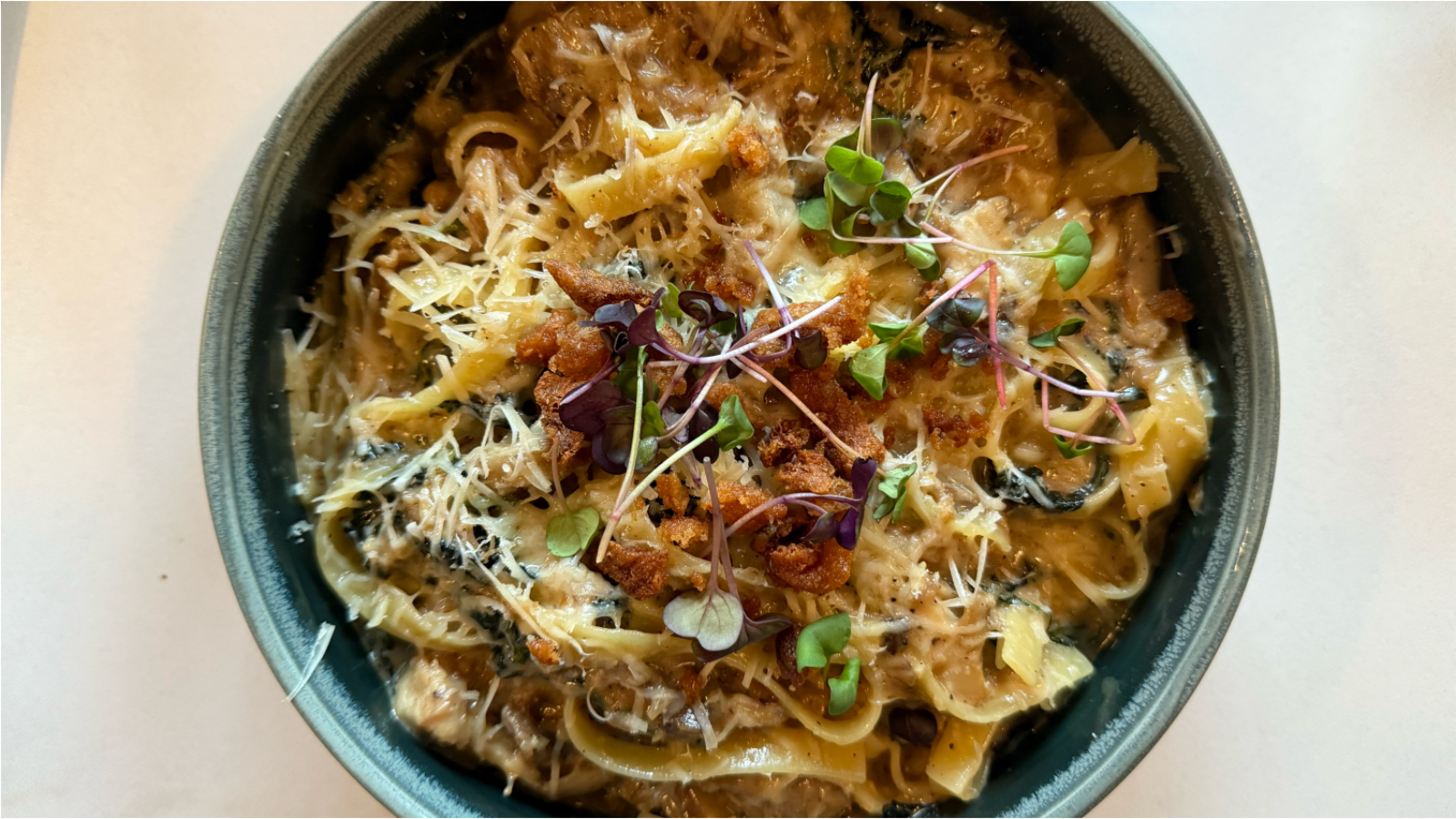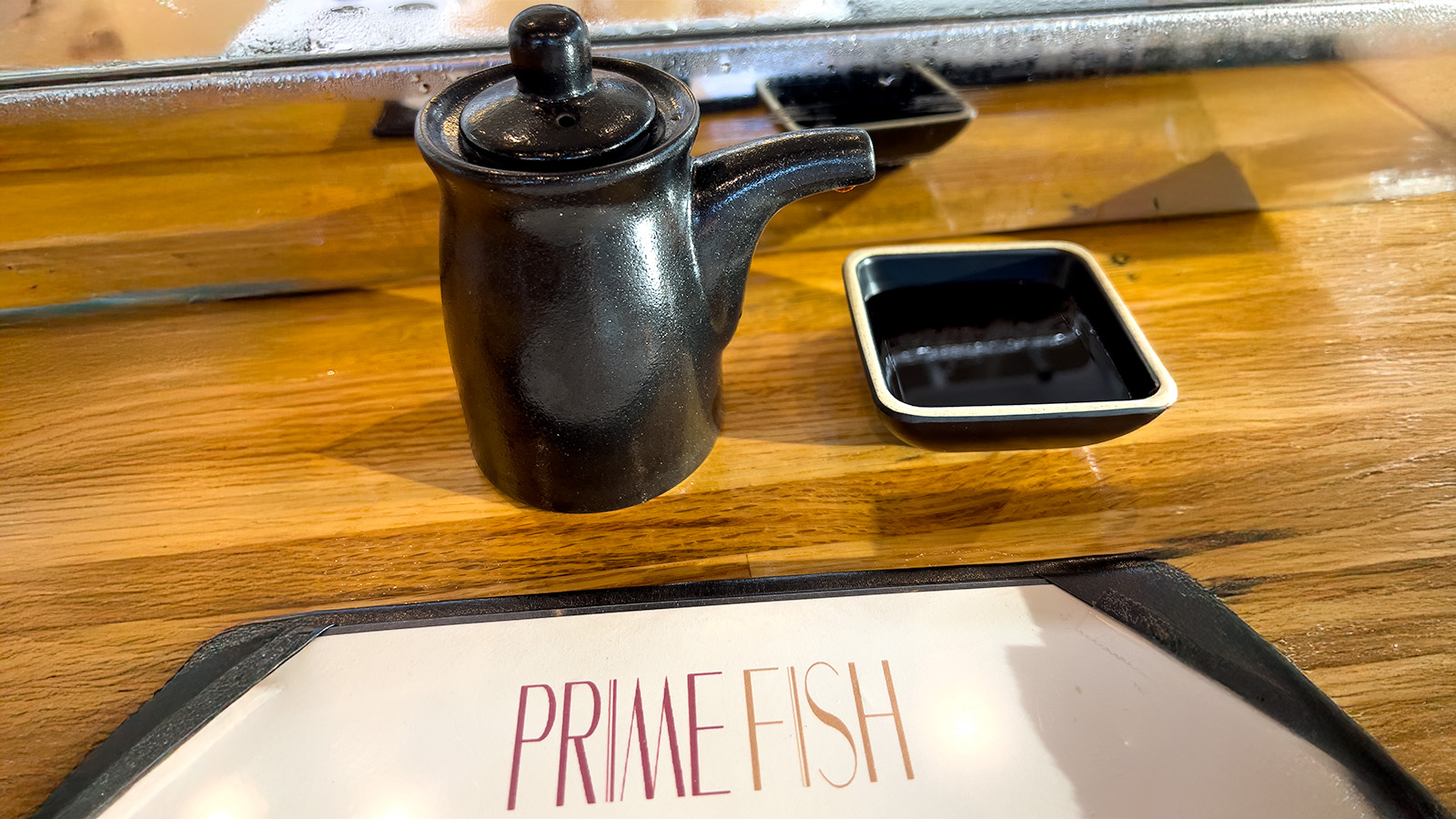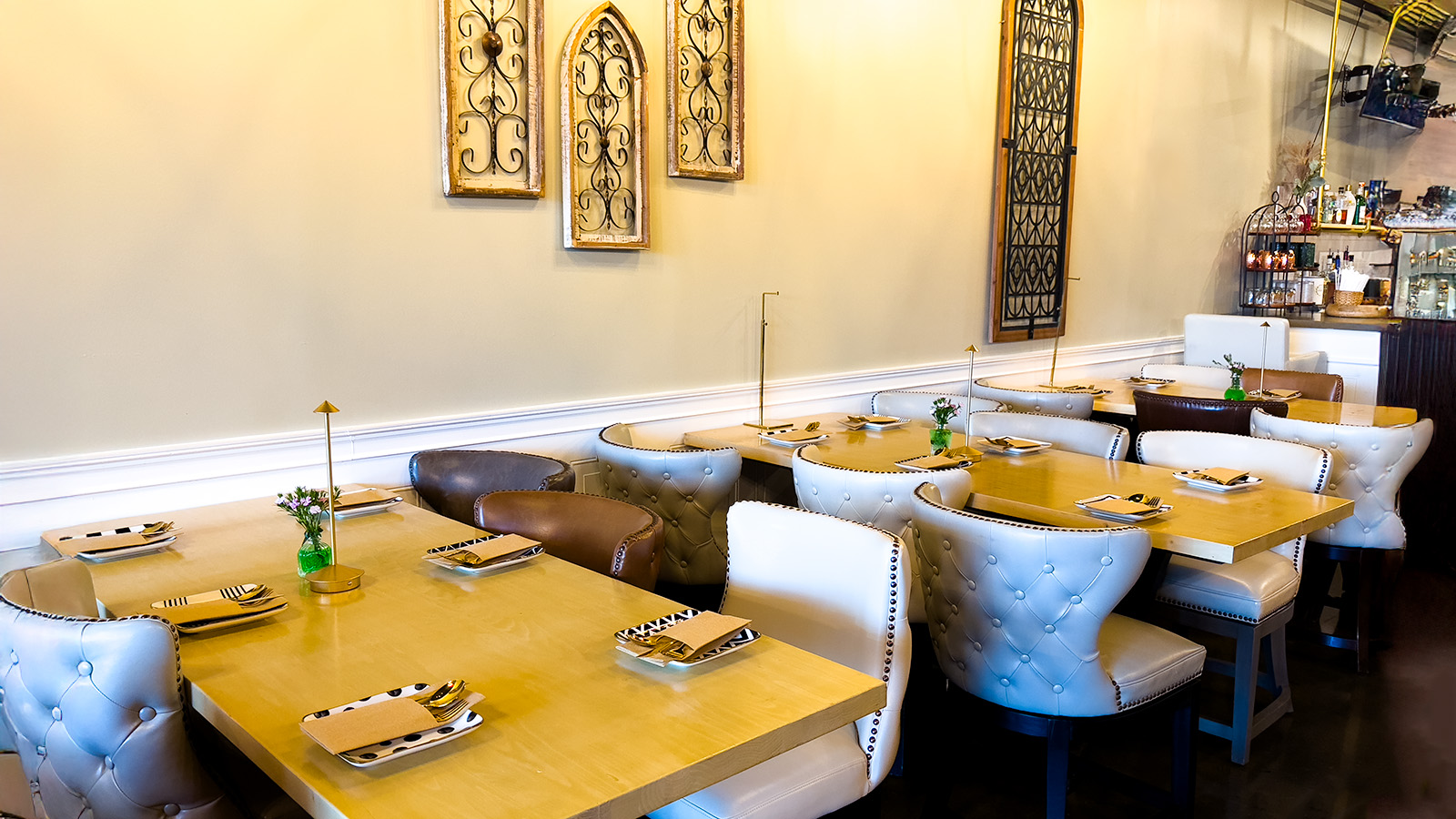
Editor's Note: This story is unlocked for everyone to read courtesy of the CRVA, our partner in nourishing culinary exploration for residents and visitors of the Queen City.
August 15, 2025
Behind the Stick: Sean Teague, Folia
Charlotte native focuses on the science and flexibility of mixology
by TM Petaccia
“Behind the stick” originally comes from taphouses, as in pulling the draft beer taps, but has been adapted over the years as an industry-wide term for who is working the bar. This series profiles working bartenders in the Charlotte area to learn a bit more about them and what you can expect when they are behind the stick.
This week, we speak with Sean Teague, co-bar lead/mixologist at Folia in South End. That’s where you’ll typically find him, but his mark can be found at other Built on Hospitality properties. He has several cocktals on the Chief’s menu in NoDa, as well as represented Chief’s at the recent NCRLA Chef Showdown where he was a finalist.
“I’m very inspired by chefs around the world who push culinary boundaries through scientific discovery and are ultimately sustainable to the environments they work with,” he says. “I want to make sustainable use of local products either foraged or farmed, and using the scientific techniques at my disposal to turn it into something nostalgic and approachable to the general public. For the finals of NCRLA Chef and Mixologist Showdown, I presented a Root Beer Negroni as my cocktail. I foraged the state’s Appalachian region for the tree barks to make the root beer infusion, paying homage to the rich indigenous history of those ingredients in Native American culture, and using modern chemistry and mixology I turned it into something new while maintaining those nostalgic flavors of traditional root beer. Participating in the NCRLAs was a lot of fun. It was interesting to do something new and show a very cool story. It taught me a lot about my skills and ability to create relative to my own style. It was priceless in terms of experience.”
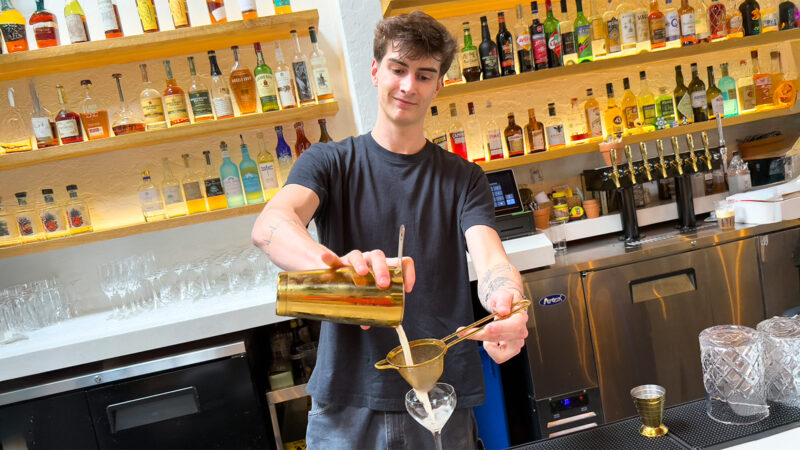
Where are you from originally?
I was born and raised in Charlotte, NC. The only time I’ve spent away was when I lived in Boone for two years of my undergrad at Appalachian State.
What got you into bartending?
I’ve worked in restaurants since I was 15, bussing tables, serving, prepping, but I hadn’t been behind the bar until May of 2024. My plan after graduating from Appalachian State was to brew beer or wine and eventually open a brewery or winery of my own. I majored in Fermentation Sciences at App State with that career goal in mind. I worked at Sycamore Brewing for five months as a cellarman and quickly came to realize it was not for me. There was very little interaction with people, little to no creative influence, and just didn’t feel like the best use of my energy. The team at Sycamore is great; I just needed something different. I saw that Built on Hospitality was opening a new cocktail bar, Chief’s. I was very interested in getting back into customer service and having worked for Chris Coleman previously, I gave him a call. He put me in touch with Bob Peters who became my mentor quickly after that. I had no experience behind the bar, just my knowledge of chemistry and food science from college and an eager to learn attitude. I started bartending at Haymaker in May of 2024 and made my way to the co-bar lead / mixologist position at Folia. I also get to help with the mixology at Chief’s as well to branch out in my creativity as much as possible.
What was your first restaurant/bar job?
Truth be told, my first job in a restaurant was bussing at Famous Toastery in Ballantyne when I was 15. But arguably the most important was my time serving at The Goodyear House in 2020. It served as a catalyst for my future in customer service, as well as showed me the unlimited potential that cultural fusion can have in food and beverage. What I learned from Chris and the team there at the time to this day inspires me to tell a story and pay homage to my roots in my cocktail making.
How would you describe your bartending style?
As I’ve only been bartending for a little over a year, I’m still developing my cocktail philosophy. Right now, I’d describe my bartending style as very intentional. One that blends culinary techniques, the scientific method, and cultural storytelling to create innovative drinks that aim to make the unknown more approachable to my guests. I’m very culinary-driven and research-oriented. I treat cocktails like dishes in a kitchen, leaning into the food science and layering flavors based on their chemical composition, making sure I’m minimizing waste, optimizing efficiency, and presenting a final product that is approachable and of course tasty. Recently, I’ve incorporated foraging into my cocktail craft, and it has furthered my interest as a flavor historian of sorts. My main goal is to always remain curious. I want my bartending style to reflect my playfully scientific experiments, that balance operational practicality and a narrative-focused presentation rooted in Southern agriculture. Long term, I aim to research the Appalachian region and express my findings through my mixology and cherish the wonderful things North Carolina has to offer, from local farms to the biodiverse forests of the mountains.
What spirit are you currently into right now?
I’ve been on a mezcal kick recently as there is so much nuance and history involved in the process. I’m a big fan of 400 Conejos. Besides that, I’m currently working on a side project with Appalachian State to make some fun distillations using local grapes. Overall, I get so curious about all the things I don’t know regarding spirits that I can’t ever choose just one. I go through phases of immediate interest. Before mezcal it was gin and before that, amaros and rum. This is what makes bartending so fun is the unlimited potential for creativity.
Do you have a particular approach or philosophy when creating a new cocktail?
The best way to describe my cocktail development is unpredictable. Ideas will randomly pop in my head no matter where or what I’m doing. I have a very disorganized folder in my notes app and a very specifically organized google drive folder of ideas I want to do or have done already. When I want to follow through on one of my ideas, I do research and follow the scientific method. I start with a topic or ingredient that is my point of inspiration and find things that relate to it, other themes, flavor parallels, contrasting flavors, etc. Once I have a plan on paper I head to the “lab” (a 3×5 kitchen prep table) to trial and tweak the drink until it’s up to my standards to present to my peers for critique and finally present to guests on the menu, as a special or whatever it may be for. I think it’s important to remember that mostly everything has been done already in some manner, (authenticity is hard to find in the current industry), but as long as you are doing something you love and putting your heart into it then that’s authentic enough for me.
What Charlotte-area bars do you like to go to when you’re not on the clock?
I love Petty Thieves and Salud for a cold beer. The food at Salud is wonderful. Substrate is a favorite for a glass of wine or an amaro pour and chat with friends. I’m also a big fan of anywhere with a good margarita, but have to have some good chips and dip to pair. Que Onda is where my girlfriend, Julia, and I usually go when we are craving this combo.
What’s your favorite cocktail?
I love everything and like trying new and fun cocktails, but if I could only drink one cocktail for the rest of my life it would be a margarita, and nothing fancy either just a good blanco tequila, fresh lime, simple syrup, and a salt rim. Preferably in pitcher format. Maybe a Modelito on the side. And don’t forget the chips and dip.
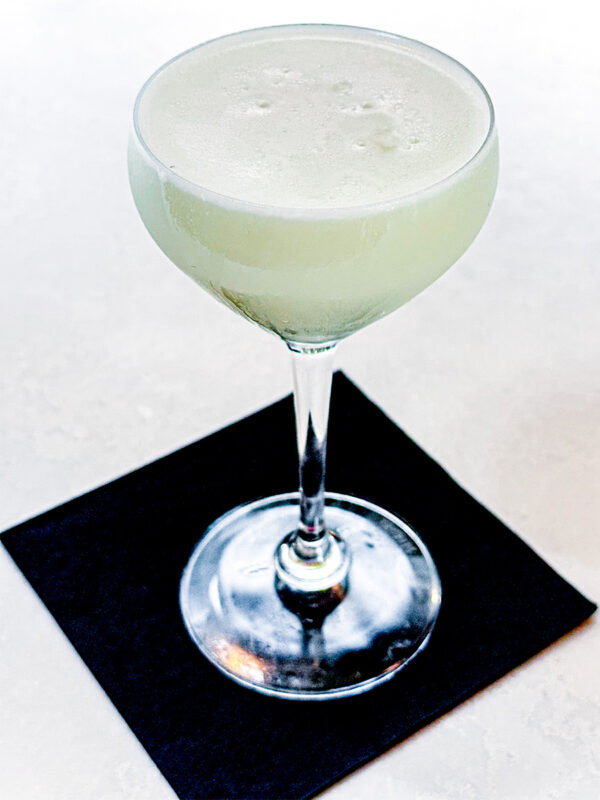
Recipe for the home bartender
Two versions of the same cocktail. One for the regular home bartender, the other, a “Tipsy Science Class” version for those of us who like to nerd it up.
Pina Verde Daiquiri
Home Version
1½ oz. silver rum (Don Q Cristal recommended)
1 oz. Coco Lopez Coconut Cream
½ oz. Faccia Brutto Centerbe (an herbal liqueur found at most area ABC stores)
½ oz. pineapple juice
¾ oz. lime juice
Science Version
1½ oz. silver rum (Don Q Cristal recommended)
1 oz. Coco Lopez Coconut Cream
½ oz. Faccia Brutto Centerbe
¾ oz. Salted Lime Acid Pineapple Juice*
Directions for both: Add all ingredients to a cocktail shaker with ice. Shake for 10 seconds or until your hands feel cold. Strain (double strain if you have a microstrainer) and pour into a coupe, martini, or Nick & Nora glass.
* Salted Lime Acid Pineapple Juice
You’ll need a digital scale. Be very accurate with measurements or else acidity and flavor will be off.
300 ml. pineapple juice
10.5 g. citric acid (found online and specialty stores)
6 g. malic acid (found online and specialty stores)
1-2% of the juice’s weight (varies by brand) in salt, typically 3-6 g.
Blend all ingredients together and let sit in fridge for about an hour so the aeration has time to settle before using in drink.
Cheers!
